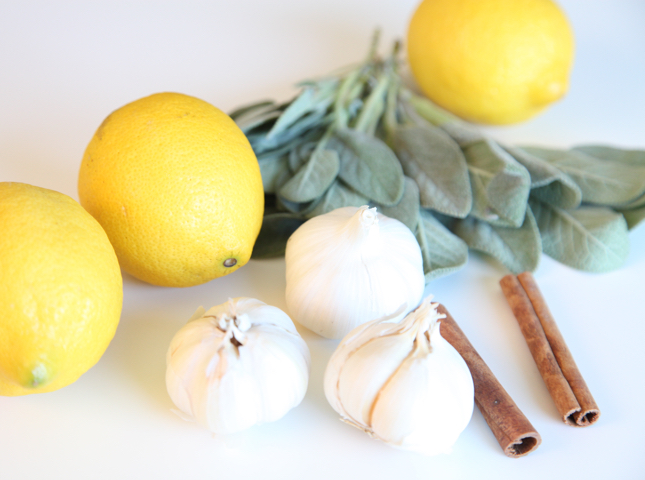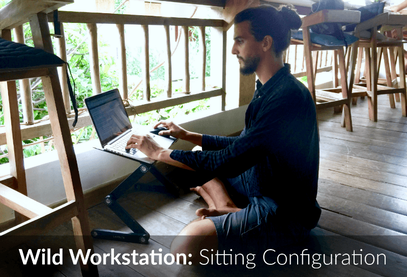 Lemon and Sage Chicken in Cream is a riff on Jamie Oliver’s recipe for chicken in milk, an unusual recipe with a fervent following. In Oliver’s recipe, a whole chicken is roasted with an odd combination of ingredients: milk, cinnamon, garlic, sage and lemon. That odd combination turns into a roasted bird swimming in an amazing sauce scented with lemon and sage. You really have to try it to believe how good it is. But consider trying this version first, which is richer, creamier and even more succulent. Using bone-in chicken thighs instead of a whole chicken cuts down on the cooking time and guarantees juicy, succulent meat. Using whole cream instead of milk results in a sauce that is rich and smooth instead of curdled. The combination of whole cream, chicken drippings and butter sends the fat content of this dish soaring, which is a good thing if adding healthy fat to your diet is a priority. This lemon and sage chicken is so good and so easy to make that it’s sure to become a favourite. Servings: 4 to 6 Time in the Kitchen: 25 minutes, plus 45 minutes in the oven Ingredients
Instructions Preheat oven to 375º F/190º C. Recipe Note: For this recipe, strips of lemon zest are better than grated zest. Using a vegetable peeler or paring knife, remove the yellow peel from most of the lemon, being careful to leave the white pith behind. Use a knife to cut the pieces of peel into thin strips. In an ovenproof skillet that will fit all the chicken, heat the avocado oil/red palm oil over medium-high heat. When the oil is hot, add the chicken, skin side down. When the chicken is nicely browned, flip it over. Carefully tilt the skillet and pour some of the oil out, leaving only a thin layer. Add the butter, garlic, cinnamon stick, sage leaves and lemon zest. Right when the butter just begins to turn brown, pour in the cream. Bring the cream to a gentle boil and then put the skillet in the oven. Cook, uncovered, for 45 minutes, until the chicken is done and the sauce is bubbly and thickened. If needed, add a little salt to the sauce before eating. (The garlic cloves can be easily slipped out of their skins while you eat.)  Tennis elbow, Achilles tendinitis, osteoarthritis, and other connective tissue injuries are on the rise. Athletes have always gotten them, but it’s only in the past few decades that regular folks are getting them too. For some connective tissue injuries, non-athletes outnumber athletes. That shouldn’t happen if the conventional wisdom—injuries to tendons, ligaments, and cartilage occur only because of overuse or overloading during intense physical activity—were true. Now, of course the way we train affects the health and function of our connective tissue. Acute injuries absolutely occur. Overuse injuries absolutely develop. But that’s to be expected. Athletes put their bodies through a lot, and there is going to be fallout from that. Where those injuries shouldn’t be happening is in regular, everyday folks who don’t train for a living or engage in intense physical competition on a regular basis. And yet that’s exactly how it’s going down in the world today. In one recent study, the majority of patients with Achilles tendon injuries couldn’t attribute their condition to working out or playing sports. In other words, they just got it. Part of the problem is our nutrition. We eat too many of the inflammatory foods which contribute to connective tissue degradation and de-conditioning, like grains and refined seed oils and sugar, and too few of the nutritive building blocks our bodies use to buttress and repair damaged connective tissue, like collagen which is the greatest source of gelatin and provides the necessary building blocks for collagen construction and repair, and provides the glycine that balances out the methionine in our meat-heavy diets and makes them less inflammatory. This is all standard stuff at this point. It’s no surprise to most of you. Eat healthy, exercise, sleep, and most other things fall into place, including the health of your connective tissues. But it can’t explain everything. There’s more to it. You don’t see people traditionally doing the downward dog, hitting the couch stretch, or doing toe touches every morning. They simply move around a lot and avoid sitting in chairs for ten hours a day, and it’s enough. Right? Mark Sisson and Matt Wallen collaborated on a pair of papers that appear in the April edition of the Journal of Bodywork and Movement Therapies that discuss the power of “Archetypal resting positions” (several positions depicted in the article) and the crisis (and solution) of “Modern disintegration and primal connectivity.” In the papers, they posit that it’s not just our tendency to sit in chairs way too much that’s destroying our health, movement quality, and tissue quality. We’re also failing to utilise the archetypal resting positions that humans have been using for hundreds of thousands of years. Sitting in chairs isn’t ideal, but far worse is our neglect of the dozen or so permutations of ancestral floor positions.
If you alternate between all the positions, every limb will receive the stretch/compression treatment that has been shown to improve tissue healing and maintain tissue viability and function. Many of these positions also restrict blood flow to specific areas of the body, a practice that has been shown to enhance connective tissue healing. You restrict the blood flow and then restore it, and the tissue gets a “rebound” effect. Now imagine doing this all the time, whenever you’re at rest. Imagine not having any chairs at all. Imagine how you’d feel—and move, and perform, and recover—if instead of spending 10 hours a day hunched over in a chair you spent 2 hours a day exposing your body to these archetypal stretch/compression positions. Not only that, but sitting in these archetypal resting positions may even improve glucose tolerance.  Hanging around at home or at the park or beach? Sure, getting down into these positions on the floor is cinch. You could easily make that work. But what about at work? What if you work in front of a computer? I’m picturing a floor-based workstation that enables the archetypal resting position as you work, sort of a low-lying modular “desk” that can be manipulated into various shapes to adhere to your particular resting position. That would be very cool and very interesting. We haven’t done the research on the cognitive effects of chair sitting vs archetypal resting positioning, but I wouldn’t be surprised if they offered some performance-enhancing effects for knowledge workers. For now, why don’t you make it a point to spend the next month doing at least one hour of archetypal floor sitting every day? See if you notice any improvements to your tissue function, and report back. I’d love to hear your results. Thanks for reading, everyone. Take care! References: Sisson M. Archetypal Resting Positions: How Sitting Like Your Ancestors Could Save Your Health, 2019 De jonge S, Van den berg C, De vos RJ, et al. Incidence of midportion Achilles tendinopathy in the general population. Br J Sports Med. 2011;45(13):1026-8. Wallden M, Sisson M. Modern disintegration and primal connectivity. J Bodyw Mov Ther. 2019;23(2):359-365. Wallden M, Sisson M. Biomechanical attractors – A paleolithic prescription for tendinopathy & glycemic control. J Bodyw Mov Ther. 2019;23(2):366-371. Taheri N, Mohammadi HK, Ardakani GJ, Heshmatipour M. The effects of passive stretching on the blood glucose levels of patients with type 2 diabetes. J Bodyw Mov Ther. 2019;23(2):394-398. |
AuthorAnurag Gill is the Head Coach at HYDRA Movement in Moonee Ponds. Archives
June 2019
Categories |
|
|

 RSS Feed
RSS Feed
